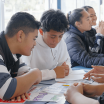Design options for emotional capacity
Engagement guideline
On this page:
On this page:
Current page section: Design options for emotional capacity
Go to top of current page: Design options for emotional capacity
Go to top of current page: Design options for emotional capacity
Go to top of current page: Design options for emotional capacity
Why this matters
Why this matters
Learners may learn to manage themselves and their emotions on their own, by trial and error or by observing others.
Many learners can benefit from more explicit supports (CAST, 2024).
Design options for emotional capacity focuses on how we support and extend emotional capacity while honouring variability among learners.
The guideline prompts us to consider how we:
The guideline also reminds us to consider:
- How will these options support learners in reaching their goals?
- Could any of these options create barriers or unnecessary challenges?
- Will all learners have fair and equal access to high-quality choices?
- How do these options reflect and respond to learner variability?
Recognise expectations, beliefs, and motivations
Recognise expectations, beliefs, and motivations
Expanding emotional capacity involves understanding motivation and how to manage frustration as a learner (CAST, 2024).
Develop awareness of self and others
Develop awareness of self and others
Offer a range of options to honour individual differences and foster identity-safe spaces (CAST, 2024).
Promote individual and collective reflection
Promote individual and collective reflection
Offer a range of individual and group assessment techniques.
Encourage learners to identify and choose ones that are optimal:
- Use charts, rubrics and visual aids to help learners track, display, and reflect on their progress.
- Design activities that provide feedback and offer scaffolds like charts, templates, or feedback displays to help learners reflect on progress.
- Promote and model strength-based language (for example, “How can I improve on the areas I find difficult?” rather than “I am not good at drawing”).
- Support opportunities for collective reflection supported by wānanga, talanoa, or art-based activities.
Cultivate empathy and restorative practices
Cultivate empathy and restorative practices
Empathy plays a vital role in collaboratively creating fair and inclusive learning environments.
It also plays a crucial role in restorative practices.
Consider building some of the options into your learning programme:
- Activities that invite listening to and considering perspectives other than one’s own.
- Content that authentically represents a diversity of lived experiences.
- Co-create and facilitate classroom agreements.
- Facilitate restorative circles or other restorative practices.
Useful resources
Useful resources

Design options for emotional capacity (UDL Guideline)
This UDL guideline invites educators to consider how to support learners to recognise and manage emotions and behaviours, and empathise with others.
As learners will vary in their emotional capacity, offering a range of support options is recommended.
This guideline supports the UDL Engagement principle.
Publisher: CAST (2024)
Next steps
More suggestions for implementing the strategy “Design multiple means of Engagement”:
-
Current page Design options for emotional capacity
Return to the guide “Universal Design for Learning”

How to use this site
Guide to Index of the guide: Universal Design for Learning
Understand:
- Why UDL is valuable
-
Find out about UDLShow suggestions for Find out about UDL
Strategies for action:
-
Design multiple means of EngagementShow suggestions for Design multiple means of Engagement
- Design options for welcoming interests
- Design options for sustaining effort
- Design options for emotional capacity
-
Design multiple means of RepresentationShow suggestions for Design multiple means of Representation
-
Design multiple means of Action and ExpressionShow suggestions for Design multiple means of Action and Expression
-
How to plan using UDLShow suggestions for How to plan using UDL
-
Design considerations in primary settingsShow suggestions for Design considerations in primary settings
-
Design considerations in secondary settingsShow suggestions for Design considerations in secondary settings
-
Design considerations in NCEA assessmentsShow suggestions for Design considerations in NCEA assessments


